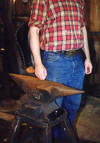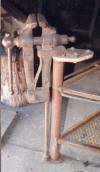Setting Up A Blacksmith's Shop
[Home] [Buying
Tools] [Setting Up Shop] [Anvils]
[Tongs] [Legvise]
[Blacksmith
Tools For Sale] [Air
Hammers] [Mechanical
Hammers]
Updated
Wednesday September 18, 2019. Under construction
 Anvil
Stands Height is determined by the height of the blacksmith who works on it.
The stand is built to allow the anvil to just touch the second knuckle joint of
the smith's loosely clenched fist when standing straight and tall. See photo at
right. If the anvil stand is made of steel or concrete then a shim of wood must
be placed beneath the anvil to absorb concussion away from the stand! Oak being a good shim type wood for the purpose. Thickness
of the shim should be at least 1-inch or more. Failure to use a shim when the
anvil is used on a hard surface will cause the bottom of the anvil to wear and
the waist to slowly bend over time.
Anvil
Stands Height is determined by the height of the blacksmith who works on it.
The stand is built to allow the anvil to just touch the second knuckle joint of
the smith's loosely clenched fist when standing straight and tall. See photo at
right. If the anvil stand is made of steel or concrete then a shim of wood must
be placed beneath the anvil to absorb concussion away from the stand! Oak being a good shim type wood for the purpose. Thickness
of the shim should be at least 1-inch or more. Failure to use a shim when the
anvil is used on a hard surface will cause the bottom of the anvil to wear and
the waist to slowly bend over time.
Forge height is something each smith needs to work out for themselves
based on weight and size of work and height of smith. It is the forge hearth
height that is important rather than the height of the sides of the forge. The
smith needs to be able to lift the iron in and out of the fire, from a
comfortable position and height which allows the arms to be held down near the
smiths sides while lifting and not reaching out in front of the smith. If the
smith works with his arms raised in the air much of the time to work with the
fire, then he will quickly develop a sore back and
shoulders. It is best to set the height of the hearth at about level with the
middle finger joints of the hand when the smith is standing straight with his
arms relaxed and making a loose fist. Somewhere close to this level should be
comfortable for any blacksmith. The level of the top of the forge hearth is set
to this level- sides or edges of the forge are not included in this measurement. An average height for a
forge hearth is around 31" or 31-1/2" tall measured from the floor.
To measure for height, stand straight and tall, arms by sides loosely,
measure from floor up to the second finger joints of the hand or to a point
midway between the second finger joints and the knuckle joint of the hand. This
measurement is the correct height of the hearth for a general purpose forge.
If the smith is designing a custom made forge, see my
Forge Design pages for more
info. Planning the forge includes the theories for height and size of forge as
well as styles and reasons for them.

 Leg vise (Post vise).
The vise is mounted to either a tree stump placed in the floor, or to a wooden
work bench or a steel bench with a wooden shim between the mounting plate of the
vise and the steel table. Never mount the leg vise to a concrete or steel bench
without a thick wooden shim between them or the mounting bolts will quickly be
worn out or pulled out due to concussion. Adjust the mounting bracket on the
rear jaw to fit the height of the bench or stump.
Leg vise (Post vise).
The vise is mounted to either a tree stump placed in the floor, or to a wooden
work bench or a steel bench with a wooden shim between the mounting plate of the
vise and the steel table. Never mount the leg vise to a concrete or steel bench
without a thick wooden shim between them or the mounting bolts will quickly be
worn out or pulled out due to concussion. Adjust the mounting bracket on the
rear jaw to fit the height of the bench or stump.
Place the vise in an area of the shop that allows open access all around the
vise for at least several feet. Keep in mind that you may be placing long bars
in the jaws of this vise so that the bars extend for a long distance sideways
from the vise (parallel with the jaws). You will want room around this vise for
working and maneuvering tools. A wide open path from the forge to this vise is
needed to allow long bars to be moved from the fire to the vise without
obstructions. The bench or stump must stand solid without wiggling during work.
A wiggling vise is annoying and may interfere with work. The photo here shows
this vise mounted to a steel 3-legged bench with a wood shim to absorb
concussion between the vise and bench. This bench is counterweighted with a
water barrel and a large set of tool racks (later filled full with tongs and
hammers and clamps).
For more on legvises go to the
Legvise page.
Latest update
Wednesday, 18 September 2019.

This page created August 26th, 2001.
 Anvil
Stands Height is determined by the height of the blacksmith who works on it.
The stand is built to allow the anvil to just touch the second knuckle joint of
the smith's loosely clenched fist when standing straight and tall. See photo at
right. If the anvil stand is made of steel or concrete then a shim of wood must
be placed beneath the anvil to absorb concussion away from the stand! Oak being a good shim type wood for the purpose. Thickness
of the shim should be at least 1-inch or more. Failure to use a shim when the
anvil is used on a hard surface will cause the bottom of the anvil to wear and
the waist to slowly bend over time.
Anvil
Stands Height is determined by the height of the blacksmith who works on it.
The stand is built to allow the anvil to just touch the second knuckle joint of
the smith's loosely clenched fist when standing straight and tall. See photo at
right. If the anvil stand is made of steel or concrete then a shim of wood must
be placed beneath the anvil to absorb concussion away from the stand! Oak being a good shim type wood for the purpose. Thickness
of the shim should be at least 1-inch or more. Failure to use a shim when the
anvil is used on a hard surface will cause the bottom of the anvil to wear and
the waist to slowly bend over time. 